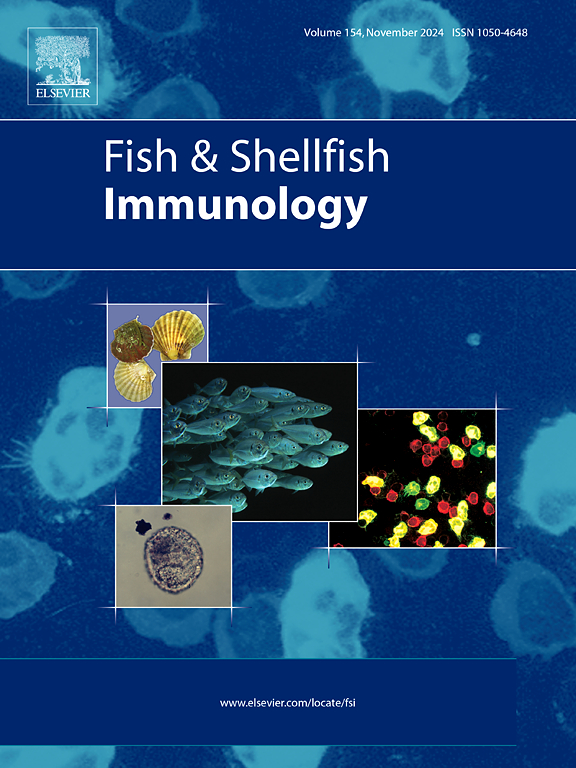Shrimp autophagy receptor protein PvTAX1BP1 regulates autophagy and facilitates white spot syndrome virus replication in Penaeus vannamei
IF 4.1
2区 农林科学
Q1 FISHERIES
引用次数: 0
Abstract
Tax1 binding protein 1 (TAX1BP1) plays a role in autophagy regulation and proteasomal pathway across different species, though its function in shrimp is still being explored. In Penaeus vannamei, the homolog PvTAX1BP1 was characterized by a CALCOCO1 domain, a LC3-interacting region (LIR), two coiled-coil domains, and two ubiquitin-binding zinc finger regions (UBZs). It was ubiquitously expressed in shrimp tissues while its expression in hemocytes was notably downregulated following white spot syndrome virus (WSSV) infection. Silencing PvTAX1BP1 reduced WSSV replication and prolonged shrimp survival, suggesting its involvement in viral pathogenesis. Immunofluorescence assay revealed co-localization of PvTAX1BP1 with the autophagy-related protein PvLC3, indicating a potential interaction and its role in LC3-mediated autophagy. Additionally, knockdown of PvTAX1BP1 resulted in downregulation of the autophagy marker PvLC3-II in WSSV-infected shrimp, reinforcing its role in autophagy regulation during infection. Both yeast two-hybrid (Y2H) and immunofluorescence assays confirmed that PvTAX1BP1 directly interacts with three WSSV proteins: WSSV325, WSSV458, and WSSV517. These findings suggest that PvTAX1BP1 facilitates WSSV replication by modulating host LC3-mediated autophagy, potentially through its interactions with WSSV proteins. This highlights a mechanism by which viruses can exploit cellular processes for their own benefit.
虾自噬受体蛋白PvTAX1BP1调节南美对虾自噬并促进白斑综合征病毒复制
Tax1结合蛋白1 (TAX1BP1)在不同物种的自噬调节和蛋白酶体途径中发挥作用,但其在对虾中的功能仍在探索中。在南美对虾中,同源基因PvTAX1BP1具有一个CALCOCO1结构域、一个lc3相互作用区(LIR)、两个线圈结构域和两个泛素结合锌指区(UBZs)。它在对虾组织中普遍表达,而在白细胞中受白斑综合征病毒(WSSV)感染后表达明显下调。沉默PvTAX1BP1可减少WSSV的复制,延长虾的存活时间,提示其参与了病毒的发病机制。免疫荧光分析显示PvTAX1BP1与自噬相关蛋白PvLC3共定位,表明其在lc3介导的自噬中可能存在相互作用及其作用。此外,PvTAX1BP1的敲低导致wssv感染对虾的自噬标记物PvLC3-II的下调,加强了其在感染过程中自噬调节的作用。酵母双杂交(Y2H)和免疫荧光实验均证实PvTAX1BP1与WSSV蛋白WSSV325、WSSV458和WSSV517直接相互作用。这些发现表明PvTAX1BP1通过调节宿主lc3介导的自噬来促进WSSV的复制,可能通过其与WSSV蛋白的相互作用。这突出了一种机制,病毒可以利用细胞过程为自己的利益。
本文章由计算机程序翻译,如有差异,请以英文原文为准。
求助全文
约1分钟内获得全文
求助全文
来源期刊

Fish & shellfish immunology
农林科学-海洋与淡水生物学
CiteScore
7.50
自引率
19.10%
发文量
750
审稿时长
68 days
期刊介绍:
Fish and Shellfish Immunology rapidly publishes high-quality, peer-refereed contributions in the expanding fields of fish and shellfish immunology. It presents studies on the basic mechanisms of both the specific and non-specific defense systems, the cells, tissues, and humoral factors involved, their dependence on environmental and intrinsic factors, response to pathogens, response to vaccination, and applied studies on the development of specific vaccines for use in the aquaculture industry.
 求助内容:
求助内容: 应助结果提醒方式:
应助结果提醒方式:


